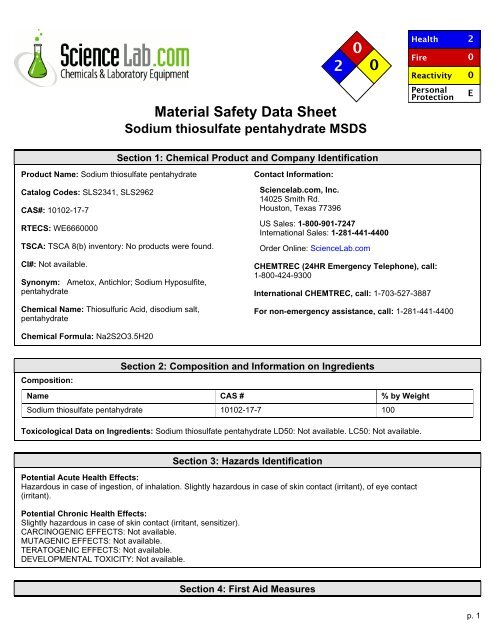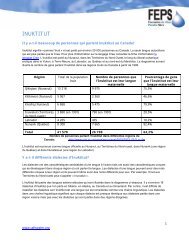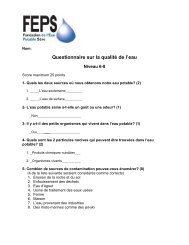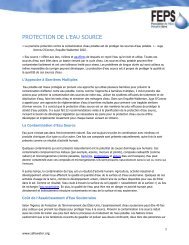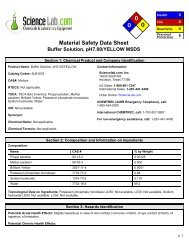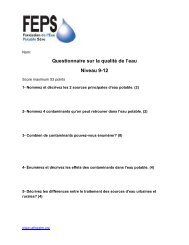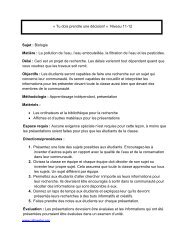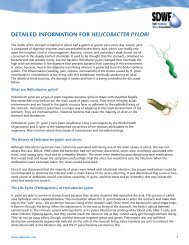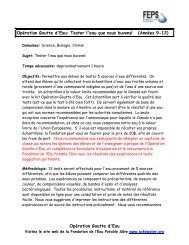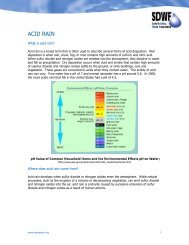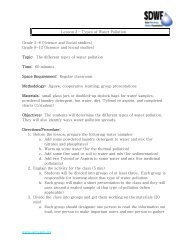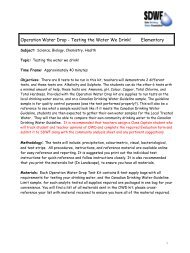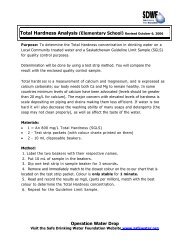Sodium thiosulfate pentahydrate MSDS
Sodium thiosulfate pentahydrate MSDS
Sodium thiosulfate pentahydrate MSDS
Create successful ePaper yourself
Turn your PDF publications into a flip-book with our unique Google optimized e-Paper software.
Material Safety Data Sheet<br />
<strong>Sodium</strong> <strong>thiosulfate</strong> <strong>pentahydrate</strong> <strong>MSDS</strong><br />
Section 1: Chemical Product and Company Identification<br />
Product Name: <strong>Sodium</strong> <strong>thiosulfate</strong> <strong>pentahydrate</strong><br />
Catalog Codes: SLS2341, SLS2962<br />
CAS#: 10102-17-7<br />
RTECS: WE6660000<br />
TSCA: TSCA 8(b) inventory: No products were found.<br />
CI#: Not available.<br />
Synonym: Ametox, Antichlor; <strong>Sodium</strong> Hyposulfite,<br />
<strong>pentahydrate</strong><br />
Chemical Name: Thiosulfuric Acid, disodium salt,<br />
<strong>pentahydrate</strong><br />
Contact Information:<br />
Sciencelab.com, Inc.<br />
14025 Smith Rd.<br />
Houston, Texas 77396<br />
US Sales: 1-800-901-7247<br />
International Sales: 1-281-441-4400<br />
Order Online: ScienceLab.com<br />
CHEMTREC (24HR Emergency Telephone), call:<br />
1-800-424-9300<br />
International CHEMTREC, call: 1-703-527-3887<br />
For non-emergency assistance, call: 1-281-441-4400<br />
Chemical Formula: Na2S2O3.5H20<br />
Section 2: Composition and Information on Ingredients<br />
Composition:<br />
Name CAS # % by Weight<br />
<strong>Sodium</strong> <strong>thiosulfate</strong> <strong>pentahydrate</strong> 10102-17-7 100<br />
Toxicological Data on Ingredients: <strong>Sodium</strong> <strong>thiosulfate</strong> <strong>pentahydrate</strong> LD50: Not available. LC50: Not available.<br />
Section 3: Hazards Identification<br />
Potential Acute Health Effects:<br />
Hazardous in case of ingestion, of inhalation. Slightly hazardous in case of skin contact (irritant), of eye contact<br />
(irritant).<br />
Potential Chronic Health Effects:<br />
Slightly hazardous in case of skin contact (irritant, sensitizer).<br />
CARCINOGENIC EFFECTS: Not available.<br />
MUTAGENIC EFFECTS: Not available.<br />
TERATOGENIC EFFECTS: Not available.<br />
DEVELOPMENTAL TOXICITY: Not available.<br />
Section 4: First Aid Measures<br />
p. 1
Eye Contact:<br />
Check for and remove any contact lenses. In case of contact, immediately flush eyes with plenty of water for at<br />
least 15 minutes. Cold water may be used. Get medical attention if irritation occurs.<br />
Skin Contact:<br />
Wash with soap and water. Cover the irritated skin with an emollient. Get medical attention if irritation develops.<br />
Cold water may be used.<br />
Serious Skin Contact: Not available.<br />
Inhalation:<br />
If inhaled, remove to fresh air. If not breathing, give artificial respiration. If breathing is difficult, give oxygen. Get<br />
medical attention.<br />
Serious Inhalation: Not available.<br />
Ingestion:<br />
Do NOT induce vomiting unless directed to do so by medical personnel. Never give anything by mouth to an<br />
unconscious person. If large quantities of this material are swallowed, call a physician immediately. Loosen tight<br />
clothing such as a collar, tie, belt or waistband.<br />
Serious Ingestion: Not available.<br />
Flammability of the Product: Non-flammable.<br />
Auto-Ignition Temperature: Not applicable.<br />
Flash Points: Not applicable.<br />
Flammable Limits: Not applicable.<br />
Products of Combustion: Not available.<br />
Section 5: Fire and Explosion Data<br />
Fire Hazards in Presence of Various Substances: Not applicable.<br />
Explosion Hazards in Presence of Various Substances:<br />
Risks of explosion of the product in presence of mechanical impact: Not available.<br />
Risks of explosion of the product in presence of static discharge: Not available.<br />
Fire Fighting Media and Instructions: Not applicable.<br />
Special Remarks on Fire Hazards: When heated to decomposition it emits toxic fumes of sulfur oxides, hydrogen sulfide,<br />
and sodium oxide<br />
Special Remarks on Explosion Hazards: An explosion may occur if triturated with nitrates, chlorates, or permanganates.<br />
Section 6: Accidental Release Measures<br />
Small Spill:<br />
Use appropriate tools to put the spilled solid in a convenient waste disposal container. Finish cleaning by<br />
spreading water on the contaminated surface and dispose of according to local and regional authority<br />
requirements.<br />
Large Spill:<br />
Use a shovel to put the material into a convenient waste disposal container. Finish cleaning by spreading water<br />
on the contaminated surface and allow to evacuate through the sanitary system.<br />
p. 2
Section 7: Handling and Storage<br />
Precautions:<br />
Do not breathe dust. Wear suitable protective clothing. In case of insufficient ventilation, wear suitable respiratory<br />
equipment. If you feel unwell, seek medical attention and show the label when possible. Keep away from<br />
incompatibles such as oxidizing agents, acids, alkalis.<br />
Storage: Hygroscopic. Keep container tightly closed. Keep container in a cool, well-ventilated area.<br />
Section 8: Exposure Controls/Personal Protection<br />
Engineering Controls:<br />
Use process enclosures, local exhaust ventilation, or other engineering controls to keep airborne levels below<br />
recommended exposure limits. If user operations generate dust, fume or mist, use ventilation to keep exposure to<br />
airborne contaminants below the exposure limit.<br />
Personal Protection: Safety glasses. Lab coat. Dust respirator. Be sure to use an approved/certified respirator or equivalent.<br />
Gloves.<br />
Personal Protection in Case of a Large Spill:<br />
Splash goggles. Full suit. Dust respirator. Boots. Gloves. A self contained breathing apparatus should be used<br />
to avoid inhalation of the product. Suggested protective clothing might not be sufficient; consult a specialist<br />
BEFORE handling this product.<br />
Exposure Limits: Not available.<br />
Section 9: Physical and Chemical Properties<br />
Physical state and appearance: Solid.<br />
Odor: Odorless.<br />
Taste: Saline.<br />
Molecular Weight: 248.19 g/mole<br />
Color: Colorless. White.<br />
pH (1% soln/water): pH of a 5% solution: 6.0-8.4<br />
Boiling Point: >100°C (212°F)<br />
Melting Point: 48°C (118.4°F)<br />
Critical Temperature: Not available.<br />
Specific Gravity: 1.7 - 1.75(Water = 1)<br />
Vapor Pressure: Not applicable.<br />
Vapor Density: Not available.<br />
Volatility: Not available.<br />
Odor Threshold: Not available.<br />
Water/Oil Dist. Coeff.: Not available.<br />
Ionicity (in Water): Not available.<br />
p. 3
Dispersion Properties: See solubility in water.<br />
Solubility:<br />
Soluble in cold water, hot water.<br />
Solubility in water:<br />
79 g/100 ml @ 4 deg. C (39 deg. F)<br />
680 g/liter @ 20 deg. C<br />
Stability: The product is stable.<br />
Instability Temperature: Not available.<br />
Conditions of Instability: Incompatible materials, moisture<br />
Section 10: Stability and Reactivity Data<br />
Incompatibility with various substances: Reactive with oxidizing agents, acids, alkalis.<br />
Corrosivity: Non-corrosive in presence of glass.<br />
Special Remarks on Reactivity:<br />
It is a strong reducing and can react with oxidizers.<br />
Reacts with acids to release sulfur dioxide.<br />
<strong>Sodium</strong> Thiosulfate <strong>pentahydrate</strong> dissolves in its own water of hydation; it effloresces in warm dry air.<br />
<strong>Sodium</strong> Thiosulfate <strong>pentahydrate</strong> loses water at 100 deg. C.<br />
It is incompatible with iodine, acids, lead, mercury, and silver salts (e.g. silver nitrate), halogens.<br />
Hygroscopic; keep container tightly closed. Protect from moisture<br />
Special Remarks on Corrosivity: Not available.<br />
Polymerization: Will not occur.<br />
Routes of Entry: Inhalation. Ingestion.<br />
Toxicity to Animals:<br />
LD50: Not available.<br />
LC50: Not available.<br />
Chronic Effects on Humans: Not available.<br />
Other Toxic Effects on Humans:<br />
Hazardous in case of ingestion, of inhalation.<br />
Slightly hazardous in case of skin contact (irritant).<br />
Special Remarks on Toxicity to Animals: Not available.<br />
Section 11: Toxicological Information<br />
Special Remarks on Chronic Effects on Humans: Not available.<br />
Special Remarks on other Toxic Effects on Humans:<br />
Acute Potenial Health Effects:<br />
Skin: It may cause mild skin irritation.<br />
Eyes: Can cause mechanical eye irritation.<br />
Inhalation: May cause upper respiratory tract and mucous membrane irritation.<br />
Ingestion: <strong>Sodium</strong> Thiosulfate is an agent with a low order of toxicity. Ingestion of large doses may cause<br />
gastrointestinal irritation disturbances with nausea, vomiting, addominal cramping, diarrhea, metabolic acidosis,<br />
and hypernatremia. May also affect respiration (cyanosis, respiratory stimulation), cardiovascular(hypotension),<br />
behavior (ataxia, convulsions)<br />
p. 4
Chronic Potential Health Effects:<br />
Skin: Prolonged or repeated skin contact may allergic dermatitis, and irritation.<br />
The toxicological preperties of this substance have not been fully investigated.<br />
Ecotoxicity: Not available.<br />
BOD5 and COD: Not available.<br />
Section 12: Ecological Information<br />
Products of Biodegradation:<br />
Possibly hazardous short term degradation products are not likely. However, long term degradation products may<br />
arise.<br />
Toxicity of the Products of Biodegradation: The product itself and its products of degradation are not toxic.<br />
Special Remarks on the Products of Biodegradation: Not available.<br />
Section 13: Disposal Considerations<br />
Waste Disposal:<br />
Waste must be disposed of in accordance with federal, state and local environmental<br />
control regulations.<br />
Section 14: Transport Information<br />
DOT Classification: Not a DOT controlled material (United States).<br />
Identification: Not applicable.<br />
Special Provisions for Transport: Not applicable.<br />
Federal and State Regulations: No products were found.<br />
Other Regulations: Not available.<br />
Other Classifications:<br />
WHMIS (Canada): Not controlled under WHMIS (Canada).<br />
DSCL (EEC):<br />
This product is not classified according<br />
to the EU regulations.<br />
S24/25- Avoid contact with skin and eyes.<br />
S28- After contact with skin, wash immediately<br />
with plenty of water.<br />
S37- Wear suitable gloves.<br />
S45- In case of accident or if you feel unwell,<br />
seek medical advice immediately (show the<br />
label where possible).<br />
HMIS (U.S.A.):<br />
Health Hazard: 2<br />
Fire Hazard: 0<br />
Section 15: Other Regulatory Information<br />
p. 5
Reactivity: 0<br />
Personal Protection: E<br />
National Fire Protection Association (U.S.A.):<br />
Health: 2<br />
Flammability: 0<br />
Reactivity: 0<br />
Specific hazard:<br />
Protective Equipment:<br />
Gloves.<br />
Lab coat.<br />
Dust respirator. Be sure to use an<br />
approved/certified respirator or<br />
equivalent. Wear appropriate respirator<br />
when ventilation is inadequate.<br />
Safety glasses.<br />
References: Not available.<br />
Other Special Considerations: Not available.<br />
Created: 10/11/2005 12:38 PM<br />
Last Updated: 11/06/2008 12:00 PM<br />
Section 16: Other Information<br />
The information above is believed to be accurate and represents the best information currently available to us. However, we<br />
make no warranty of merchantability or any other warranty, express or implied, with respect to such information, and we<br />
assume no liability resulting from its use. Users should make their own investigations to determine the suitability of the<br />
information for their particular purposes. In no event shall ScienceLab.com be liable for any claims, losses, or damages of any<br />
third party or for lost profits or any special, indirect, incidental, consequential or exemplary damages, howsoever arising, even<br />
if ScienceLab.com has been advised of the possibility of such damages.<br />
p. 6


